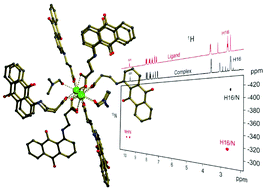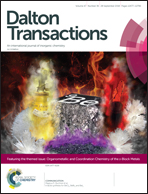Design and synthesis of a family of 1D-lanthanide-coordination polymers showing luminescence and slow relaxation of the magnetization†
Abstract
We have designed and synthesized eight isostructural 1D coordination polymers (CPs) with the general formula {[Ln(aapc)3(DMF)]}n [where Ln(III) = Y (2), La (3), Nd (4), Eu (5), Gd (6), Tb (7), Dy (8), Er (9); and aapc = 3-((anthraquinone-1-yl)amino)propanoate]. These CPs consist of Ln-carboxylate infinite rods in which the bulky anthraquinone scaffolds arise from it in such a way that the resulting supramolecular packing exhibits isolated 1D chains. Solution structures have been corroborated through NMR methods including PGSE and EXSY NMR studies and, due to the presence of lanthanide ions, magnetic and luminescence properties have been studied. Alternating current magnetic measurements of compound 8 show slow relaxation of the magnetization, a characteristic of single molecule magnets (SMMs). The evaluation of solid-state photophysical properties reveals that the aapc scaffold sensitizes lanthanide(III) based emission of compounds 4–9 both in the visible and near-infrared (NIR) regions at 10 K.



 Please wait while we load your content...
Please wait while we load your content...